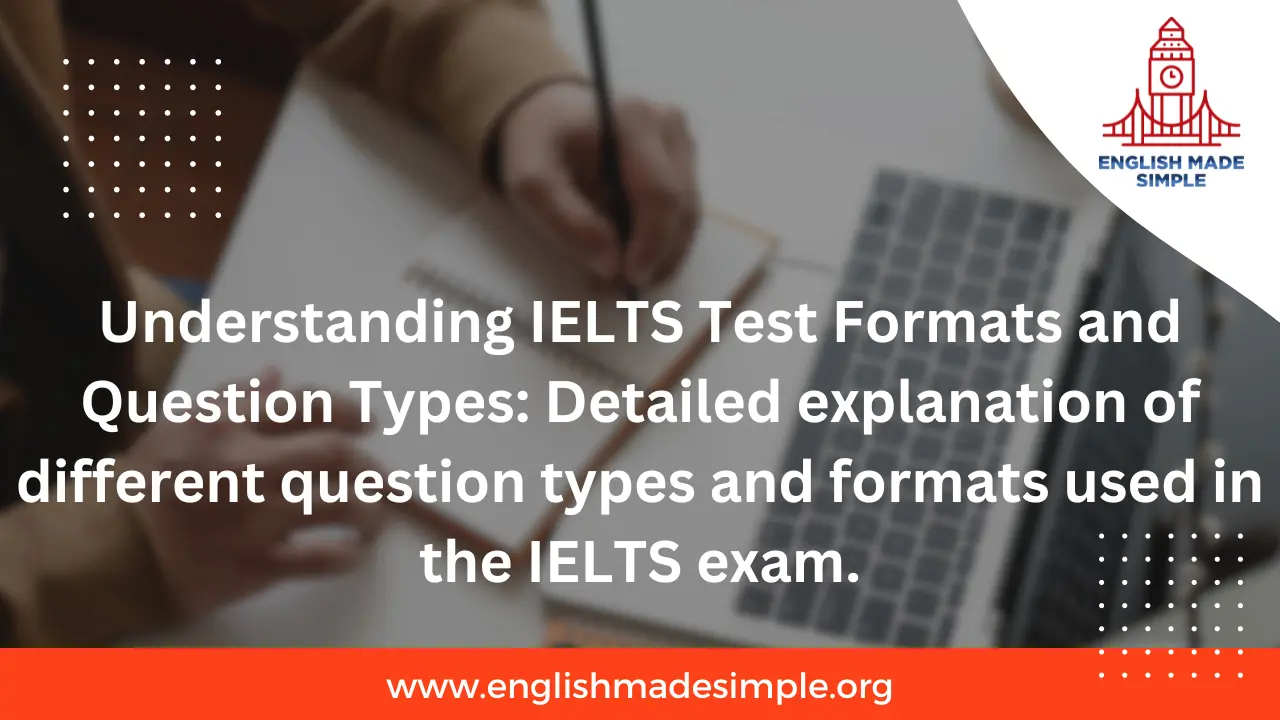
Understanding IELTS Test Formats and Question Types
The IELTS (International English Language Testing System) is designed to evaluate the language proficiency of non-native English speakers. It is widely accepted for academic, professional, and immigration purposes. Understanding the test format and the various question types is essential for effective preparation. This blog provides a detailed explanation of the different formats and question types used in the IELTS exam.
Overview of the IELTS Test
The IELTS test is divided into two main versions:
- IELTS Academic: For those applying for higher education or professional registration.
- IELTS General Training: For those seeking work experience, training programs, or immigration purposes.
Both versions assess four language skills: Listening, Reading, Writing, and Speaking.
IELTS Listening Section
Format: The Listening section consists of four recorded monologues and conversations, and it lasts for 30 minutes. Test-takers have an additional 10 minutes to transfer their answers to the answer sheet.
Question Types:
- Multiple Choice: Choose the correct answer from a list of options.
- Matching: Match a list of items to a set of options.
- Plan/Map/Diagram Labeling: Label a plan, map, or diagram based on the information provided in the recording.
- Form/Note/Table/Flow-chart/Summary Completion: Fill in the gaps in a form, notes, table, flow-chart, or summary.
- Sentence Completion: Complete sentences using words from the recording.
- Short Answer Questions: Answer questions using words from the recording.
IELTS Reading Section
Format:
- Academic Reading: Three long texts which range from descriptive and factual to discursive and analytical. It lasts for 60 minutes.
- General Training Reading: Three sections with texts extracted from books, magazines, newspapers, notices, advertisements, company handbooks, and guidelines.
Question Types:
- Multiple Choice: Choose the correct answer from a list of options.
- Identifying Information (True/False/Not Given): Determine if statements are true, false, or not given in the text.
- Identifying Writer’s Views/Claims (Yes/No/Not Given): Decide if statements agree with the writer’s views.
- Matching Information: Find specific information in the text and match it to a list of options.
- Matching Headings: Match headings to paragraphs or sections of the text.
- Matching Features: Match features (e.g., names, dates) to statements in the text.
- Matching Sentence Endings: Match the beginning of a sentence to its correct ending.
- Sentence Completion: Complete sentences using words from the text.
- Summary/Note/Table/Flow-chart Completion: Fill in the gaps in a summary, notes, table, or flow-chart.
- Diagram Label Completion: Complete labels on a diagram.
- Short Answer Questions: Answer questions using words from the text.
IELTS Writing Section
Format:
- Academic Writing: Two tasks to be completed in 60 minutes.
- Task 1: Describe visual information (e.g., graphs, charts, maps).
- Task 2: Write an essay in response to a point of view, argument, or problem.
- General Training Writing: Two tasks to be completed in 60 minutes.
- Task 1: Write a letter (e.g., formal, semi-formal, informal).
- Task 2: Write an essay in response to a point of view, argument, or problem.
Question Types:
- Task 1 (Academic): Describe and interpret data, explain the stages of a process, describe an object or event.
- Task 1 (General Training): Write a letter requesting information or explaining a situation.
- Task 2 (Both): Write an essay responding to a point of view, argument, or problem. This may include discussing advantages/disadvantages, problems/solutions, causes/effects, or presenting and justifying an opinion.
IELTS Speaking Section
Format: The Speaking section is a face-to-face interview with an examiner, lasting 11-14 minutes. It consists of three parts.
Question Types:
- Part 1 (Introduction and Interview): Answer general questions about yourself and various familiar topics (e.g., home, family, work, studies, interests). Duration: 4-5 minutes.
- Part 2 (Long Turn): Speak about a particular topic based on a task card. You will have 1 minute to prepare and 1-2 minutes to speak. Follow-up questions may be asked.
- Part 3 (Discussion): Answer further questions connected to the topic in Part 2. This involves discussing more abstract ideas and issues. Duration: 4-5 minutes.
Tips for Understanding and Handling Different Question Types
- Practice Regularly: Familiarize yourself with the various question types by practicing regularly with official IELTS practice materials.
- Time Management: Develop time management skills by practicing under timed conditions.
- Analyze Mistakes: Review your answers, especially the incorrect ones, to understand your mistakes and learn from them.
- Expand Vocabulary: Enhance your vocabulary to handle different types of questions, especially for reading and writing sections.
- Develop Strategies: Learn and practice strategies for each question type. For example, skimming and scanning for reading, note-taking for listening, and planning for writing.
- Seek Feedback: For the speaking and writing sections, seek feedback from teachers or peers to improve your responses.
Conclusion
Understanding the IELTS test formats and question types is a crucial step in effective preparation. By familiarizing yourself with the structure and practicing each type of question, you can improve your performance and increase your confidence on test day. Remember, consistent practice and targeted study are key to achieving a high score on the IELTS exam.
